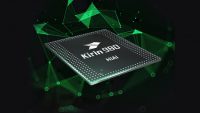Huawei Kirin 980: First 7nm Mobile Chip Amps Up Processing
September 6, 2018
Huawei, in partnership with Taiwan Semiconductor Manufacturing Company (TSMC), debuted the Kirin 980, the first mobile chip fabricated on a 7nm process. The Kirin 980 features 6.9 billion onboard transistors, about 1.6 times the number on the Kirin 970, while shrinking the die size down from 10nm. The result offers a 40 percent reduction in power consumption, and a 20 percent improvement in several processing metrics. That feat took 1,000 senior engineers three years and more than 5,000 prototypes to achieve success.
VentureBeat reports that, “the Kirin 980 is also the first out of the gate with ARM’s Cortex-A76, a new core architecture built on the company’s DynamiQ technology,” which was introduced in 2017, and “offers fine-grained speed and power management controls.”

According to VB, “the Kirin 980 has an eight-core architecture with two Cortex-A76 2.6GHz ‘high-performance cores’ for demanding tasks, two Cortex-A76 1.92GHz ‘middle cores’ that juggle everyday processes, and four 1.8GHz Cortex-A55 ‘efficiency cores’ that step in for light workloads like music playback.” All eight cores are rarely in play simultaneously, but a “flexible scheduling mechanism” taps them when needed. A high-end game, for example, requires “four efficiency cores and two middle cores or some combination of high-performance cores and middle cores.”
It’s this flexibility that makes the Kirin 980 so energy efficient, with Huawei stating that “the 980 sucks down 33 percent less power than Qualcomm’s Snapdragon 845.” Adding to the efficiency are support for 2133MHz RAM with a 20 percent “bandwidth advantage” and the Mali-G76 graphics chip “that’s 46 percent faster and 178 percent more efficient than the Kirin 970’s Mali-G72.” A dual ISP also “processes photos up to 46 percent faster and 23 percent more efficiently than the previous model.”
Huawei noted the Kirin 980 uses HDR technology and a multi-pass noise reduction algorithm to capture “better contrast” and “finer details.” With motion tracking, “the ISP can recognize subjects with 97.4 percent accuracy and track them across a frame, and it shoots clips with 33 percent shorter delay, thanks to a new video processing pipeline.”
Huawei’s Neural Processing Unit (NPU) was introduced with the Kirin 970, and the Kirin 980 accelerates machine learning with its heterogeneous computing structure (HiAI) that “automatically distributes voice recognition, natural language processing, and computer vision workloads across it dynamically.”
The Kirin 980 has two NPUs (the Kirin 970 only had one) and “can recognize up to 4,500 images per minute, compared to [Qualcomm’s] Snapdragon 845’s 2,371 images and [Apple’s] A11 Bionic’s 1,458.”
Huawei also stated that the Kirin 980’s modem is “the fastest it’s ever produced,” hitting speeds up to 1.4Gbps (LTE Cat. 21) and supporting “carrier aggregation across frequency bands, allowing it to hop between operators with relative ease.” The Kirin 980’s modem has the “world’s fastest Wi-Fi,” with downlink speeds “reaching 1,732Mbps,” and a GPS receiver delivering 10 times better positioning accuracy via a new frequency — L5 (1575.42 MHz).
Related:
Fact Check: Huawei Flaunts Kirin 980 Gains Over Snapdragon 845, But Are They Meaningful?, Android Authority, 9/3/18

No Comments Yet
You can be the first to comment!
Sorry, comments for this entry are closed at this time.